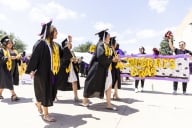You have /5 articles left.
Sign up for a free account or log in.
WASHINGTON – In the weeks and months after 9/11, the talk in the United States was about the need to be better prepared to understand the culture and languages of the Middle East. There was a surge of college students enrolling in Arabic and Persian. More than a decade later, that initial surge is showing signs of slowing down even while the world focuses on the Arab world again as homegrown pro-democracy movements shake up governments in the region.
A report unveiled Friday at the annual conference of the Middle East Studies Association by the National Middle East Language Resource Center took stock of the state of Middle East language enrollments in higher education, and the challenges ahead, in part because of declining government support for such programs.
The report shows that Arabic language enrollments went up by 60 percent for undergraduate students while declining by 20 percent for graduate students in the years 2006-2009. In all, enrollments went up by 54 percent during the period; in 2002-2006, by contrast, the numbers jumped by 130 percent.
Though the growth seems impressive, the large percentage increases are due in part to an incredibly small base. Total Arabic enrollments of just over 35,000 are a small fraction of those in languages such as Spanish (more than 864,000) and French (216,000), according to data from the Modern Language Association.
Recent Arabic Enrollments (MLA Survey Data)
| 1998 | 2002 | 2006 | 2009 |
1998- 2002 |
2002-6 | 2006-9 | |
| Two-year | 1,158 | 1,859 | 4,384 | 6,235 | 61% | 136 % | 42% |
| Undergraduate | 3,212 | 7,502 | 17,442 | 28,066 | 134% | 132% | 60% |
| Graduate | 445 | 531 | 940 | 782 | 19% | 77% | -20% |
| Total | 4,815 | 9,892 | 22,766 | 35,083 | 105% | 130% | 54% |
The number of students enrolling in Persian went up by 29 percent between 2006-9; in 2002-6, the numbers rose 97 percent. For modern Hebrew, the numbers declined by 18 percent in 2006-2009, compared to a 7 percent gain in the previous period. Turkish enrollments held steady overall, though there was a 41 percent decline in graduate student enrollments.
Surveys by the NMELRC show that many students desire to master these languages, but there is a lack of trained teachers in the field. “We do not have the coaches we would like to have,” said R. Kirk Belnap, director of the NMELRC and professor of Arabic at Brigham Young University.
The dearth is most evident in the teaching of Arabic, he said. “Of greatest concern is the fact that most students of Arabic are undergraduates and therefore typically less-experienced language learners — and they are increasingly enrolled at institutions that have little or no experience in assisting students in acquiring advanced-level skills, the goal of most students,” the report says.
A data analysis by the center shows that students learning Arabic at a new program were very unlikely to end up qualifying for yearlong fellowships at the Center for Arabic Study Abroad, an acclaimed program that receives federal and private funding. But even CASA faces federal cutbacks, and the 2012-13 academic year may only see 25 fellowships awarded, a decrease of nearly half compared with previous years -- though the cuts are also partially due to the turmoil in Syria.
Success stories shared in the study include the teaching of Hebrew at Middlebury College and Brandeis University; a summer language institute teaching Persian at the University of Texas at Austin; and an intensive Arabic course at Cornell University. But heartening as these examples are, there is a lack of new talent to help students, and absence of full-time faculty is a problem at many colleges. “Those who teach language are increasingly appointed as lecturers, who often have little or no job security or influence in the departmental and programmatic decision-making process,” the report says.
Belnap called it a two-tier system wherein the study of languages is often not recognized as a first-rate academic discipline. Teacher satisfaction is low and most lecturers would not recommend that students major in a language, according to the study. And the bright scholars in the field tend to gravitate toward more traditional disciplines like literature or history. “The bottom line is we cannot expect significant improvements in the applicant pool if the jobs available are clearly second-class positions,” according to the report.
And although enrollment numbers continue to grow, some language departments could do with more students.
“We desperately need more master’s and Ph.D. students in Hebrew,” said Shmuel Bolozky, professor of Hebrew at the University of Massachusetts at Amherst and a co-author of the report published Friday.
Hebrew, he pointed out, lacks the ability to produce job offers in the way that study of Arabic and Persian can.
The two other scholars who worked on the study are Kamran Talattof, a professor of Persian Language and Literature at the University of Arizona, and Erika Gilson, a professor of Turkish at Princeton University.
All of them say that change can come when there is an institutional culture that values strong language programs. The study points to successful high school language programs like Arabic Without Walls, and the need to have more such programs.
Language departments were urged in the report to set realistic but challenging goals. “This would include: wise pre-and post-measurement of student learning outcomes; frequent observation (including peers observing peers) and team discussion of how to improve; regular program evaluation,” the study says.
Belnap said that the current slowdown in enrollment is only a temporary blip, and points to the current turmoil in the Middle East as one reason why there will be renewed interest in languages from that part of the world.








